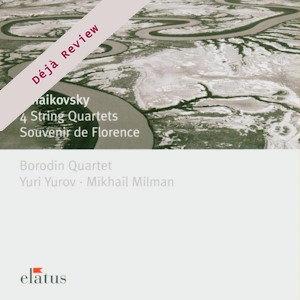
Déjà Review: this review was first published in October 2004 and the recording is still available.
Pyotr Ilyich Tchaikovsky (1840-1893)
String Quartet No.1 in D Op.11 (1871) [28.50]
String Quartet in B flat major (1865) [13.21]
String Quartet No.2 in F Op.22 (1874) [35.29]
String Quartet No.3 in E flat minor Op.30 (1876) [38.15]
Souvenir de Florence Op.70 (1890) [34.25]
Borodin Quartet
Yuri Yurov (viola), Mihail Milman (cello)
rec. 1993, Teldec Studios, Berlin; Snape Maltings Concert Hall, UK
Elatus 2564 617742 [151]
Tchaikovsky was still studying at St Petersburg’s Conservatory when he began work on the B flat major string quartet in August 1865, only to abandon it three months later after completing only the tri-partite first movement. Cast in usual sonata form, the first subject has its origins in a Russian folksong, unsure of major or minor mode. His last chamber work, the string sextet entitled Souvenir de Florence, was written at his summer retreat at Frolovskoye near Klin barely three years before the composer’s death, and recalls a visit he had made to Italy. Its Adagio recalls his Fifth Symphony, and though all the other three movements are in the minor, there is nevertheless a more cheerful feel to the work than such a characteristic would imply. Tchaikovsky’s three string quartets were written in the 1870s as the composer was beginning to put together the building blocks of his career. The First, in 1871, was dashed off as part of a programme of his latest music, which he pragmatically decided should be of chamber music rather than more expensive orchestral fare. Its style varies between harking back to the classical period while a Russian folksong (a snatch of the Song of the Volga Boatman is easily identifiable) is said to have moved the author Tolstoy to tears (it was later arranged for cello and orchestra). The rest consists of a whimsical scherzo with rhythmic aberrations and a sonata-form finale. Three years later the Second Quartet opens with interesting chromatic dissonances, the scherzo once again offsets rhythmic interplay of duple and triple metre, the slow movement takes its listener to the depths of Tchaikovsky’s emotional despair, while the finale employs devices such as fugue and homophony. The Third Quartet was written a couple of years later in 1876, in the year his violin concerto was finally given its premiere by Brodsky in Vienna under Richter. In the uncomfortable key for a string player of E flat minor, the work seems more personalised than its predecessors. It was dedicated to the violinist Ferdinand Laub, who had died the year before, so a funeral march becomes its pivotal third movement, while the preceding joyous scherzo is notably brief. Only the more cheerful Rondo-Finale sweeps away the mood of pervading gloom and tragedy.
These are superb performances given by one of the world’s finest string quartets, with special mention made of the lavish textures achieved in the sextet. Unanimity of ensemble is exemplary, the sound finely judged and balanced at both Russian and UK venues. The Borodin Quartet’s playing is suffused with directness and simplicity of phrasing, and no better rendition of the Russian style comes to mind. The clever emphasis on the composer’s witty rhythmic inventiveness (forever playing with uneven five-in-a-bar time signatures), and the magical experience of listening to a group of four players sounding at times like a string orchestra of forty will remain indelibly unforgettable. Tchaikovsky’s output of chamber music for strings is very well served by this double set of excellent discs.
Christopher Fifield
Help us financially by purchasing from



















